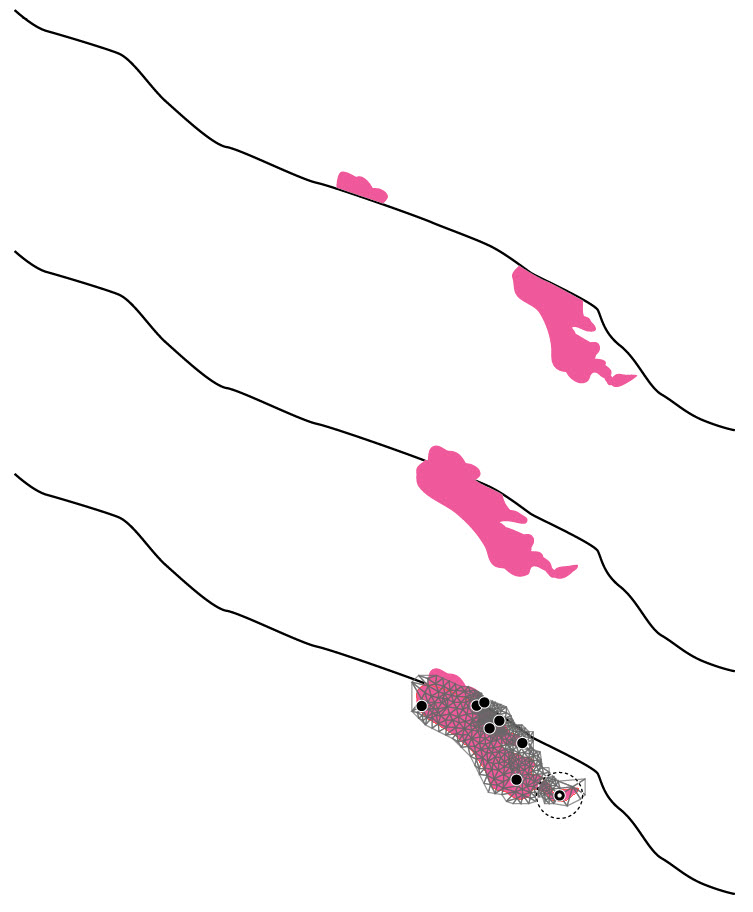- Home
- Illustrator
- Discussions
- Re: Restoring strike-slip fault on a geologic map
- Re: Restoring strike-slip fault on a geologic map
Copy link to clipboard
Copied
Hello,
Do you know if there is a way in Illustrator to restore on a geologic map displaced outcrops along a strike-slip fault plane??
N.B: The strike-slip fault in geology, is a plane of deformation which displaces a rock outcrop (object) horizontally (after splitting it into two parts). I have attached a link of an image where you can see a pink outcrop displaced by a fault over almost 80km. In fact, I am a PhD student in geology. I would like to do this but I am not sure if it is possible.
Hope I was clear, and someone will help me.
Thank you.
 1 Correct answer
1 Correct answer
I don't really know what you're starting out with, but if it's a raster image, it might be easier to work with if you trace the main parts manually. Then, like Jacob mentioned, the non-straight line will require more than just a move. I would recommend using Puppet Warp (Transform vector graphics using the Puppet Warp tool ) to make the deformation. Below are before and after examples (with the last one showing the mesh from the deformation) based on the image in the link you provided.

Explore related tutorials & articles
Copy link to clipboard
Copied
What do you want to draw?
There are a couple of elements on your examples. Please point out your issue. Only a rare minority here might be geologists.
Copy link to clipboard
Copied
Thanks for your remark.
I would like to draw a geologic map with contours (representing the outcrops) and a line (representing the strike-slip fault).
Then, I would like to move (displace) the outcrops (contours) existing on the right side of the fault (line), along the fault line itself (which is not perfectly straight), so that those right outcrops join their equivalents on the left side of the fault (because they both have been displaced by the fault with certain distance). On the image that I shared (link), you can see the pink contours displaced (80km) on both sides of the fault (line). So, I would like to let one of them join the second by displacing it along the fault plane/line itself, using the same offset (offset=80km).
Is it clear?
Thank you
Copy link to clipboard
Copied
Please draw a sketch.
Copy link to clipboard
Copied
Alaa-Azam,
As I (mis)understand it, you wish to recreate how (part of) the area looked/would have looked before/without the 80 km displacement.
Obviously, the displacement would apply to a long strecth, maybe decreasing towards some ends far away.
One fundamental issue is that displacement along a non straight fault line will inevitably cause deformation in the direction across the line, and therefore it is impossible to perform a simple Move; areas such as the top left pink part will have a (maybe insignificant) deformation, depending on how far away from the fault line the deformation extends/is distributed and upon the actual displacement history: the top left pink part has undergone an initial compression (where the fault line curves upwards) followed by an inflation on the other side of that, and also a rotation (first a bit one way, then more the other way).
Undoubtedly you know all this.
I presume you are using a redrawing or Image Tracing, preferably getting strokes rather than filled areas for parts like the fault line and the Jinsha River (see tracing options).
The following descriptions/considerations apply to moving the parts north of the fault line.
You may start by rotating and moving a copy of each part, such as the the top left pink part to a first fit along the bottom right pink part, then adapt by scaling (trying to keep the area more or less constant); you may rotate it anticlockwise corresponding to a horizontal fault line in order to (easily) scale along it, then rotate it back, going back and forth until you are satisfied, and do the same in connexion with a possible scaling across; you may look at the area of the bounding path.
Obviously, you will also have to deal with the (almost literally) disturbing fact that the Jinsha River has come much closer to the fault line than it was originally.
It seems that the top left pink has been compressed along the fault line (more or less east to west), and therefore should be stretched and correspondingly compressed in the northerly southerly direction.
A similar change of the area round the Jinshan River probably applies.
Copy link to clipboard
Copied
Jacob, thank you very much for your answer! Exactly, this is what I am asking about. You understood very well what I would like to do. Certainly, I know all the issues that you’ve described in your first paragraph and the problem of the restoration is due to the fact that the fault line is not perfectly straight (containing a translational and rotational components).
But I was wondering if Illustrator could have a feature that allows me (if I trace the main parts manually and separately) to let me move (“glide”) the right pink part against the fault’s trace in one single move (I mean if Illustrator can recognize the fault’s trace and let the right pink part follows this fault-line path) until joining the right pink part. However, I conclude based upon your answer that it is impossible to do that and the only way is to try doing what you’ve explained in your descriptions (play with rotation and scaling etc.) because this is exactly what I thought about before asking my question.
However, I would like to tell you that the image that I’ve given you is very simplistic compared to the map which I would like to restore, because I wanted to ask about the concept. The map which I would like to restore is much more complicated than this and containing many displaced objects. It would not be easy. I hope I will succeed…
Copy link to clipboard
Copied
I don't really know what you're starting out with, but if it's a raster image, it might be easier to work with if you trace the main parts manually. Then, like Jacob mentioned, the non-straight line will require more than just a move. I would recommend using Puppet Warp (Transform vector graphics using the Puppet Warp tool ) to make the deformation. Below are before and after examples (with the last one showing the mesh from the deformation) based on the image in the link you provided.

Copy link to clipboard
Copied
Myra, thank you very much for your answer and thanks also for the examples that you’ve drawn. It is exactly what I would like to do. Yes I am going to use a raster image (the geologic map) and recreate/draw the main parts on it separately and manually before doing the restoration.
As I told Jacob before, I was wondering if Illustrator could have a feature that allows me (if I trace the main parts manually and separately) to let me move (“glide”) the right pink part against the fault’s trace in one single move (I mean if Illustrator can recognize the fault’s trace and let the right pink part follows this fault-line path) until joining the right pink part.
However, this Puppet Warp tool seems interesting because in your sketches, you could restore the displacement perfectly. I didn’t try it before. However I didn’t understand very well what are the black points on the last example? Are those the pins that I should create using the Puppet Warp tool? And you put the pins on both left and right parts of the displaced objects, or only on one of them?
Copy link to clipboard
Copied
Yes, the black points are pins. You can move and/or rotate any pin. When you select your shape then select the Puppet Warp Tool, Illustrator will automatically add pins to the mesh. You can add more pins for more precise control of deformations wherever you want.
Find more inspiration, events, and resources on the new Adobe Community
Explore Now
